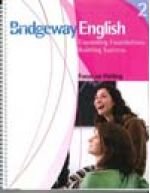Bridgeway English 1 and 2 are remedial or review courses that are likely to be used together over a period of from one to two years by students in junior or senior high. The combined course is most suitable for review or remediation since it covers all of the grammar and usage taught up through about eighth grade, as well as some skills high schoolers should acquire such as how to complete a job application form.
Bridgeway English 1 (BE 1): Focus on Grammar covers the eight parts of speech, sentences, prepositional phrases, the roles of nouns within sentences, pronoun agreement with antecedents, and similar basic concepts.
Bridgeway English 2 (BE 2): Focus on Writing shifts toward composition skills as it teaches about sentence variety, clauses, and various ways to construct sentences correctly. Further along, it teaches practical forms of writing such as letter writing, writing out directions for a task, and completing an Application for Employment. However, the course is self-instructional, and there are a limited number of actual writing assignments. Instead, the emphasis is primarily on grammar and usage skills such as subject-verb agreement, punctuation, and capitalization. A few editing and proofreading exercises reinforce learning. Brief lessons on other topics such as study skills, critical thinking, state abbreviations used by the Post Office, budgeting time, and identifying fact versus fiction expand coverage to other skills students should learn.
There is no sentence diagramming in these courses. Many exercises have students underline or otherwise mark certain sentence elements (e.g., underlining subordinating conjunctions in BE 1, Pak 5, p. 18). I found only one exercise in BE 2 where students identify all parts of speech.
Each course book is a collection of 12 Paks similar to Alpha Omega’s LIFEPAC curriculum and A.C.E.’s Pace curriculum. Students are supposed to work independently, reading lesson material and examples then completing exercises. Exercises are similar to what you find in other traditional language arts courses: fill-in-the blanks, select the correct answer from two options, underline particular sentence elements, complete charts, add correct punctuation, and occasionally write in their own individual responses in words or sentences.
Each Pak has a review test and a self-test, both of which students may take on their own. Parents check the answers to exercises, reviews, and tests. Parents should go over the self-test with students before giving them the final test for that Pak. This is to ensure that any weak areas are revisited before the final test. When a student has mastered all of the lessons in a Pak, the parent administers a test. If the student passes, he or she moves on to the next Pak. If not, they are to review the lessons. (Since books and tests will have been written in previously, reviewing will not give students the opportunity to repeat the exercises and the tests unless you photocopy the test pages in advance to use as backups.)
While these are not literature courses, sentences in exercises sometimes make literary references such as, ”George Elliot’s real name is Mary Ann Evans,” and, “Another author with a pen name was O. Henry” (BE 1, Pak 2, p 23). “Tremendous Tales” scattered throughout the student worktexts often include stories about literary works or authors although they also address many other topics such as the different versions of spoken English around the world (BE 1, Pak 3, p. 1) and the benefits of laughter (BE 2, Pak 12, p. 15). So some literature elements are included even though these courses cannot be considered as covering literature itself.
The aforementioned Tremendous Tales are provided as interesting reading material, but they do not tie into the lessons. Students are likely to figure this out and skip them unless you require them to be read and verify this in some fashion—if it matters to you. Character-building quotations, some from famous people, are also scattered throughout the worktexts.
Each worktext is spiral bound so that books will lie flat as students write in them. The worktexts are consumable, so each student needs his or her own set of books. They are printed in black and white, and while they have a few photos, the illustrations are primarily from clip art.
A single Teacher Answer Key covers both student course books. The Teacher Answer Key has reduced images of student pages with answers overprinted. Tests are at the back of each student worktext, and these should be removed by the parent or teacher before books are given to students.
Summary
While Bridgeway English might not be particularly exciting, it might be just the right option for students who need a thorough review of grammar and usage before they can move on to advanced language arts courses. Junior high students might want to use Bridgeway English in preparation for high school courses, although a few activities such as the job application might better be saved for when they are older. The courses might also be used for high school students who are not going on to college, but who would like to master the basic skills of grammar and writing that they need for success in life.









